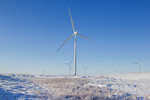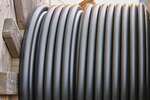02/17/2009
Product Pick of the Week - The Switch
The Switch a provider of megawatt-class permanent magnet generator and full-power converter packages for wind power and other new energy applications, has announced technologies to enable wind installations to more effectively capture wind power and transform it to significantly higher energy production. With its innovative drive train technology, The Switch plans to take successes gained in European and Asian wind installations to bolster its presence in North America, one of the highest growth areas for new wind turbine installations. With production facilities in Hudson, NH, The Switch is well positioned to address the needs of North American customers in 2009 and beyond.
In the race to harness the wind, turbine manufacturers have sought an ideal drive train configuration that increases energy production and limits power losses. Based on years of experience with industrial drive applications, The Switch has developed a drive train for the wind power business that utilizes an optimized permanent magnet generator (PMG) and full-power converter package. This unique drive train, The Switch Drive, allows active power extracted from the turbine, as well as the reactive power produced, to be individually and precisely controlled over the entire operating speed range.
"The Switch Drive not only offers substantially improved costs, but the efficiency of the PMG at partial speed is superior to that of conventional double-fed or squirrel-cage systems. This technology has become the obvious choice for the industry and in some operational points, wind turbines using our PMG and full-power converter are seeing up to 20% higher partial load efficiency, yielding more energy," states Jukka-Pekka Mäkinen, President and CEO of The Switch. "Another advantage of The Switch Drive is its ability to tune itself to individual sites and seasonal conditions."
Specific advantages of PMGs and full-power converters include:
Permanent magnet generators: In the wind power industry, PMGs have distinct advantages over conventional double-fed machines. They typically produce efficiency levels up to 98% at the rated point. When used in low-speed, direct-drive applications, generator efficiency is not quite as high, but the need for a gearbox is eliminated, creating excellent overall drive train efficiency. The true strength of PMGs is in partial load situations -- the state in which turbines most often operate due to wind inconsistency. PMG efficiencies remain very high -- close to nominal value -- over a wide range of speeds, thereby producing much higher energy yields.
The PMG is a simple form of synchronous generator that requires no connections and energy feed to the rotor. Permanent magnets are placed on the rotor to create excitation -- a major factor in delivering greater efficiency, as this design virtually eliminates rotor losses. By driving the generator with an optimal power factor using PMG technology, stator-side losses are also minimized. PMGs do not require any separate excitation systems, thereby reducing cost, simplifying the system, and improving system efficiency. Further, no slip rings are used, greatly reducing maintenance needs.
By allowing a wide range of speeds, the drive train can run at the optimized operation point for the turbine. Control is based on the optimum turbine curve and is not limited by the drive train, thereby providing better partial load rates. A double-fed machine, conversely, has a limited speed range that does not allow the turbine to fully adapt to actual site conditions.
PMGs easily meet the needs of modern wind farm turbines with ranges from 500 kW to 5 MW and higher. The Switch has commercially produced and successfully delivered a range of PMGs -- direct-driven, medium speed, and high speed -- for OEM customers in Europe, China, and more recently, the U.S. Direct-driven PMGs have minimal wearing parts, making them the most reliable, while high-speed PMGs have the traditional three-stage gearbox, with known reliability problems. Medium-speed drives represent a compromise between the two and will likely be the choice of the big turbine players in the future.
Full-power converters: A full-power converter enables easy power factor control, which means that all the current can be used for active or reactive power generation. This allows for a 100% reactive power feed, even in the absence of wind.
The Switch full-power converter is optimized to work with a range of PMG concepts. It features lightweight construction, modular power packs with liquid or air cooling, highly customizable software to match all turbine designs and wind conditions, and a rugged design that provides greater fault tolerance and grid support through fault ride-through (FRT) functionality. It is not as sensitive to changes in the network as traditional converters, and offers control advantages for adapting to ever-changing operational conditions.
Moreover, because it is designed for the highest level of performance to lower demands on the grid, the robust grid-side converter assures stable and high-quality electricity. For example, the converter was designed to assure low harmonics, which meet IEEE 519 requirements, resulting in extremely low flicker. These considerations allow for greater flexibility in selecting turbine sites.
About The Switch:
The Switch provides unique power conversion systems -- power converters, machines, and other electrical equipment needed for distributed power generation and industrial processes. Customers use the innovative products and systems of The Switch as part of their own machines or systems in wind turbines and other renewable energy applications or energy-conserving applications. The Switch solutions support the battle against climate change and help to preserve energy resources. The Switch is headquartered in Vantaa, Finland with production facilities in Hudson, NH.
For more information on this product and company, please contact Trevor Sievert at ts@windfair.net
In the race to harness the wind, turbine manufacturers have sought an ideal drive train configuration that increases energy production and limits power losses. Based on years of experience with industrial drive applications, The Switch has developed a drive train for the wind power business that utilizes an optimized permanent magnet generator (PMG) and full-power converter package. This unique drive train, The Switch Drive, allows active power extracted from the turbine, as well as the reactive power produced, to be individually and precisely controlled over the entire operating speed range.
"The Switch Drive not only offers substantially improved costs, but the efficiency of the PMG at partial speed is superior to that of conventional double-fed or squirrel-cage systems. This technology has become the obvious choice for the industry and in some operational points, wind turbines using our PMG and full-power converter are seeing up to 20% higher partial load efficiency, yielding more energy," states Jukka-Pekka Mäkinen, President and CEO of The Switch. "Another advantage of The Switch Drive is its ability to tune itself to individual sites and seasonal conditions."
Specific advantages of PMGs and full-power converters include:
Permanent magnet generators: In the wind power industry, PMGs have distinct advantages over conventional double-fed machines. They typically produce efficiency levels up to 98% at the rated point. When used in low-speed, direct-drive applications, generator efficiency is not quite as high, but the need for a gearbox is eliminated, creating excellent overall drive train efficiency. The true strength of PMGs is in partial load situations -- the state in which turbines most often operate due to wind inconsistency. PMG efficiencies remain very high -- close to nominal value -- over a wide range of speeds, thereby producing much higher energy yields.
The PMG is a simple form of synchronous generator that requires no connections and energy feed to the rotor. Permanent magnets are placed on the rotor to create excitation -- a major factor in delivering greater efficiency, as this design virtually eliminates rotor losses. By driving the generator with an optimal power factor using PMG technology, stator-side losses are also minimized. PMGs do not require any separate excitation systems, thereby reducing cost, simplifying the system, and improving system efficiency. Further, no slip rings are used, greatly reducing maintenance needs.
By allowing a wide range of speeds, the drive train can run at the optimized operation point for the turbine. Control is based on the optimum turbine curve and is not limited by the drive train, thereby providing better partial load rates. A double-fed machine, conversely, has a limited speed range that does not allow the turbine to fully adapt to actual site conditions.
PMGs easily meet the needs of modern wind farm turbines with ranges from 500 kW to 5 MW and higher. The Switch has commercially produced and successfully delivered a range of PMGs -- direct-driven, medium speed, and high speed -- for OEM customers in Europe, China, and more recently, the U.S. Direct-driven PMGs have minimal wearing parts, making them the most reliable, while high-speed PMGs have the traditional three-stage gearbox, with known reliability problems. Medium-speed drives represent a compromise between the two and will likely be the choice of the big turbine players in the future.
Full-power converters: A full-power converter enables easy power factor control, which means that all the current can be used for active or reactive power generation. This allows for a 100% reactive power feed, even in the absence of wind.
The Switch full-power converter is optimized to work with a range of PMG concepts. It features lightweight construction, modular power packs with liquid or air cooling, highly customizable software to match all turbine designs and wind conditions, and a rugged design that provides greater fault tolerance and grid support through fault ride-through (FRT) functionality. It is not as sensitive to changes in the network as traditional converters, and offers control advantages for adapting to ever-changing operational conditions.
Moreover, because it is designed for the highest level of performance to lower demands on the grid, the robust grid-side converter assures stable and high-quality electricity. For example, the converter was designed to assure low harmonics, which meet IEEE 519 requirements, resulting in extremely low flicker. These considerations allow for greater flexibility in selecting turbine sites.
About The Switch:
The Switch provides unique power conversion systems -- power converters, machines, and other electrical equipment needed for distributed power generation and industrial processes. Customers use the innovative products and systems of The Switch as part of their own machines or systems in wind turbines and other renewable energy applications or energy-conserving applications. The Switch solutions support the battle against climate change and help to preserve energy resources. The Switch is headquartered in Vantaa, Finland with production facilities in Hudson, NH.
For more information on this product and company, please contact Trevor Sievert at ts@windfair.net
- Source:
- The Switch
- Author:
- Posted by: Trevor Sievert Online Editorial Journalist
- Email:
- ts@windfair.net
- Link:
- www.windfair.net/...
- Keywords:
- The Switch, wind energy, renewable energy, jobs, wind turbine, wind power, wind farm, rotorblade, onshore, offshore


























